Falconers in the Middle Ages would affix plates to their falcons with seals of their owners.
Banding (or "ringing" if you're British) for scientific purposes began in 1899 with Christian Mortensen, a Danish schoolteacher, using zinc rings on European starlings, hawks, storks, etc.
Banding comes in many forms: leg bands, neck collars, radio transmitters, dyeing of feathers and wing tags.
Aside from banding the bird, measurements like weight, toe pad length, wingspan, etc. are collected.
From the USGS:
The first records of banding in North America are those of John James Audubon, the famous American naturalist and painter. In 1803 he tied silver cords to the legs of a brood of phoebes near Philadelphia and was able to identify two of the nestlings when they returned to the neighborhood the following year.
Today, the program stretches from the Canadian Arctic to the tropics of Latin America, from Newfoundland to the far Pacific islands, and beyond to places like Siberia, Greenland, and Antarctica. Wherever North American birds go, bird banding is there.
Virtually all species are, or have been, banded. Currently, 1,200,000 birds are banded, and 85,000 recovered, each year. More than 63,000,000 birds have been banded since the beginning of the program, and 3,500,000 have been recovered and reported to the banding offices. Millions more have been recaptured or resighted by banders.
These banders include federal and state conservation agencies; university associates; avocational ornithologists; bird observatories; environmental centers; nongovernmental organizations; environmental consulting firms, and other private sector businesses. Currently, more than 6,100 banders are operating in US and Canada.
If you are a birder, you know the value of bird banding. The sheer physical abilities of the birds, the distances they travel, their life spans, trends in migration and a species status among a changing environment...all are known thanks to banding.Some fun wild bird banding stats:
Gray catbird banded in Florida was found in Pennsylvania 13 years later.
Atlantic puffin....lived for 31 years, 11 months.
Great Horned Owl...lived for 28 years.
Red-tailed hawk: 28 years, 10 months.
I have a favorite saying, and I wish I knew who coined it. Here it is:
We conserve only what we love.
We love only what we understand.
We understand only what we are taught.
Non-birders or those who have not had the opportunity of this knowledge might have some opinions about banding birds. Maybe they think we are "harassing" wildlife, that we are dooming a bird to die by placing a metal or plastic band to its leg. I'd like to help erase those opinions now.
Bird bands are very light. They are sized appropriately for the species that will wear it. A hummingbird's band weighs less than one-hundredth of a gram! By comparison, a hummingbird wearing a band is the equivalent to a human wearing a wrist watch.
We can't give a bird our phone number so they can call us to report on its whereabouts or how it's doing. A recovered band is invaluable.
Banding is done with the utmost respect given to the bird, and a bird is kept in hand no longer than absolutely necessary.
If there are those who still have doubts about banding, remember this:
We have been banding for 100 years in this country. It's working.
Now, onto some photos from a great horned owl banding:
The one chick in the nest is banded....
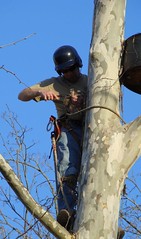
...then gently lowered to the ground to let wildlife photographers get photos of this bundle of grit and attitude that they have been obsessively watching for weeks:
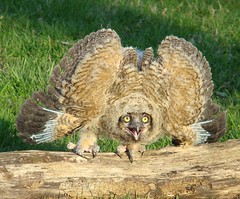
As luck would have it, an orphaned owlet needed another nest, and she was brought out to compare with Owlet #1:
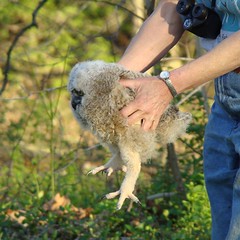
Meet your new sister:
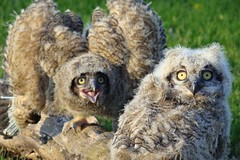
They are approximately the same age, and feeding two babies is more than manageable for the parents. (Great Horned Owls can't count, anyway!)
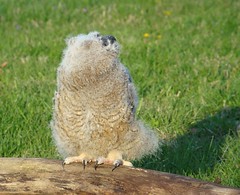
Owlet #2 looks up at her new home.
The youngin's were placed in the nest, and given a free meal. Reports from a certain Owl Sitter say that both chicks are still in the nest and the parents are preening and feeding both owlets.
This little event brought out some weird but friendly people:
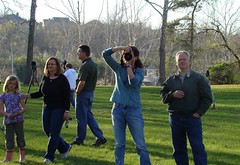
Nina, in a strangely familiar pose....
Also my mother, kids and Kathi, aka KatDoc:

I made everyone strike a pose that seems to have become a tradition...Everybody POINT!!!


11 comments:
Great photos of the bird banding. I would love to do that some day!! Owls are so cool!
Yay, Susan! I was hoping you'd fill in the blanks with a lot of background info--always a good balance when public displays bring out the crowds. And you're the resource here.
And that quote--my favorite, too, from Baba Dioum--a real keeper, and the crux of what conservation education is all about.
I can't THANK you ENOUGH, for letting me know this was happening. Such awesome birds, at arm's length--once in a lifetime for me.
Thank you.
Thanks for sharing this great event!
I was on Kat docs site and saw her version!
Wonderful stuff!
Ah, but I called them brothers rather than sisters. Of course, we wil never know, but weren't they cute?
~Kat
Fantastic. Looks at the size of those lenses....
Amazing pix Susan. That second shot belongs on your wall.
Did Kathi get grass stains on her pink pants?
...love your photos of the baby owls! So cute how the original baby is puffing himself up to look bigger. Glad I got to meet you too!! (Nina, apparently I just missed you!)
My previous comment must have gotten lost in cyberspace, but this is one great post. I had no idea the owls would simply accept and care for an orphan.
Interesting, and great photographs.
Looks good! Ringing is a lot of fun.
Kelly!!!! I forgot to mention you!!!!
CRAP!!!!
I suppose that little owl trying to look fierce doesn't realize how cute it really is!
Post a Comment